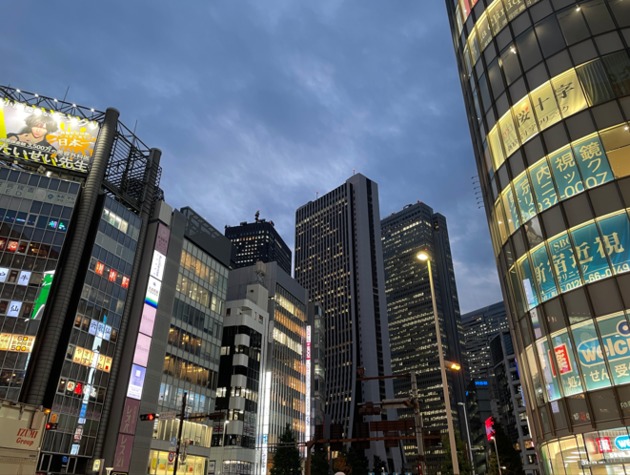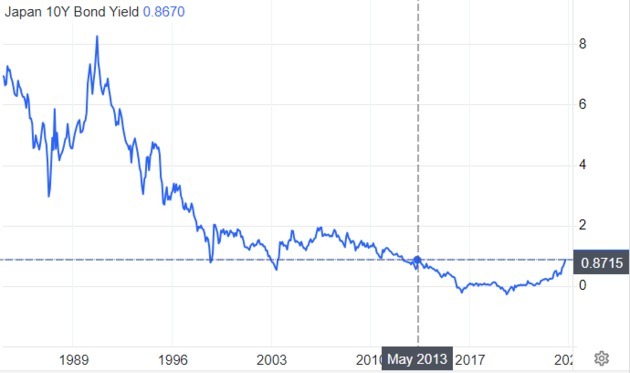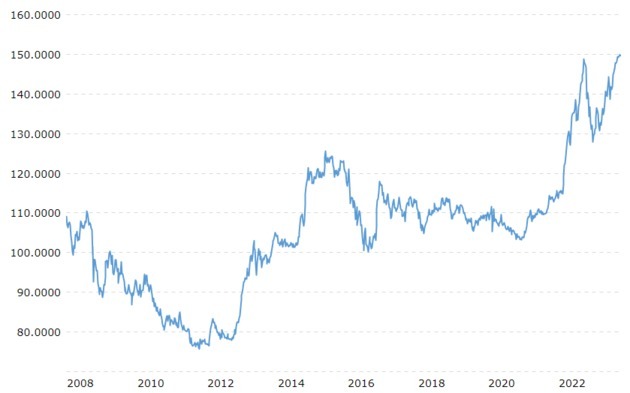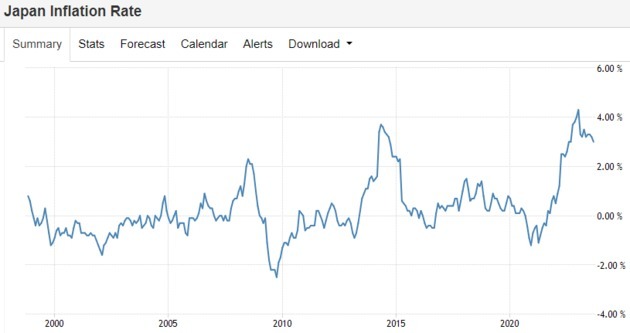
Photo/Liu Qingyan (NBD)
The Bank of Japan (BOJ) is set to announce its latest policy statement on Tuesday, October 31, and market attention is focusing on whether the central bank will further raise its yield curve control (YCC) target.
As expectations for the BOJ to raise its benchmark yield target again have risen, Japanese government bonds have come under heavy selling pressure. Last week, the 10-year Japanese government bond yield briefly touched 0.8950%, a record high since BOJ Governor Haruhiko Kuroda took office in 2013. Meanwhile, the recent acceleration in global long-term government bond yields, led by the 10-year U.S. Treasury yield, is also putting pressure on the BOJ to raise its 10-year government bond yield target at its meeting this week.
The BOJ continues to maintain the world's only negative interest rate policy, which has been in place for 10 years, while central banks in developed economies such as the Federal Reserve have begun to end their current tightening cycle. In September 2016, the BOJ also introduced YCC, which aims to keep specific Japanese government bond yields at target levels by buying bonds. Over the past seven years, YCC has become the BOJ's "anchor" for monetary policy. With the combination of zero interest rates and a strong YCC commitment,BOJ sends a clear signal to markets that it is committed to ultra-loose monetary policy. Against this backdrop, the huge yield gap between Japan and the United States has sent the yen to 30-year lows against the dollar several times since last fall.
However, as Japanese inflation and nominal wages have gradually risen this year, expectations for the BOJ to end its 10-year zero interest rate policy have grown. In an interview with Japanese media last month, current BOJ Governor Kazuo Ueda hinted that ending negative interest rates is a "viable option."
So, why is the BOJ "ignoring" the yen and sticking to ultra-loose monetary policy? Is 1 dollar to 150 yen will be the Japanese authorities' target exchange rate as market expected? When will the BOJ end YCC? Wht conditions will need to be met for normalization? Masazumi Wakatabe, who retired as BOJ deputy governor in March, recently spoke to NBD about these issues.
The Era of YCC going to an END?
NBD: The BOJ introduced YCC policy in 2016. However, long-term government bond yields in major countries around the world have been rising recently, with Japan's 10-year government bond yield touching 0.9% this week. Do you think the BOJ should further adjust the target level of the YCC policy under current global circumstances? How likely would that happen? If so, how should it be adjusted?
Masazumi Wakatabe: I think there’s a possibility that the BOJ would change the bond, even for the next meeting. the current JGB yield is approaching the so-called upper bound, which is 1%. So that the next move may be to change the bound further up.
I don't expect the BOJ to abandon the YCC policy altogether. I think they are going to modify for a while, meaning that the BOJ wants to be confident about the sustainability of the pricing development, and inflation rate at 2%. Although right now the actual inflation is above 2 %, the BOJ would like to make it sure that this is not a temporary thing. So they'll see what's going on. But as I said now 10-year JGB yield is approaching the upper bound, there is a chance that we are going to raise the upper bound. I think that's the way to do that.

Photo/Tradingeconomics
So other way I think they can do something, but I'm doubtful about if it is the right time to do that, I think that they don't want to change because there's a target level. So that would say the BOJ is going to raise the interest rate, although right now the actual interest rate has been (going) up. But the BOJ doesn't want to say that we are going to raise the interest rate.
NBD: Some market participants argued that the BoJ's July meeting (in which the bank adjusted yield curve) was the "beginning of the end". For example, PIMCO argues it means "BOJ is moving toward phasing out yield curve control". Do you agree with this view and why?
Masazumi Wakatabe: Let's say if this continues, that will be the end of the YCC. So the question is of course if the BOJ is still maintaining the upper bound, and I suppose next week the BOJ is not going to change it at all, then that the BOJ is keeping the YCC.
And also, everything depends on incoming data. Suppose that the BOJ thinks that the further modification to the YCC is not helping the BOJ to achieve 2 % inflation target in a sustainable and stable manner, then I think that the BOJ can actually terminate (the YCC policy). So although people would like to interpret the July meeting are kind of the beginning of the end of the YCC, it's still not so clear.
The USD/JPY 150 benchmark is not a target that BOJ will intervene
Ding: The BoJ has long been regarded as a maverick among global central banks, having implemented negative interest rate policies, QQE and etc. While other major central banks like the Fed, ECB and BoE have raised interest rates to post-GFC highs, the BoJ kept its ultra-loose policies no matter what for a long time, letting the JPY/USD tumble to its lowest level in over 30 years. In your view, why would the BoJ sacrifice the yen, putting inflation at risk, but insist on maintaining an ultra-loose monetary policy?
Masazumi Wakatabe: To begin with, I think that it's quite dangerous to target the exchange rate. I mean there is a famous trilemma, the free movements of capital, monetary policy autonomy, and also exchange rate stability. You cannot maintain three of them at the same time. You're gonna have to give up something.
Japan doesn't want to restrict the free mobility of capital, and the BOJ has been committed to the domestic price stability target. So that's why we're gonna have to sacrifice the exchange rate part. Now, having said that, there is an understanding that the current weakening yen is not necessarily the weakening yen only. It's more because of the strengthening US dollar because the Fed has been hiking (aggressively). So that's not the needy position for the BOJ if the BOJ is concerned with the exchange rate, but then the question is the kind of trade-off between price stability and exchange rate stability.
In that, I think the BOJ is pursuing the domestic price stability and inflation target of 2 %. That's why the BOJ has to give up the exchange rate part. There is an institutional difference between the BOJ and the Ministry of Finance Japan (MOF). So the BOJ and other central banks are not responsible for the exchange rate volatility itself, but now of course monetary policy does affect the exchange rate movement, but you can't really talk about the part directly because that would violate the institutional agreement.
So suppose that the Yen depreciates further down in a rapid manner, then I think it is possible for the MOF to do something about it. The BOJ is just an agent so the actual operations would be conducted by the BOJ but I think that the most important is what Masato Kanda does: when and to what extent they are going to maintain the exchange rate are not clear.

Photo/Macrotrends
Ding: The Japanese government made a rare intervention when USD/JPY reached 150 level in October 2022. Similarly, the yen strengthened sharply against the dollar on October 4th, leading some market participants to believe Japanese policymakers had intervened to support the currency. Yesterday's FX move sparked similar speculations. In your view, why is the ¥150 mark so important that it forced the Japanese government to step in (last year, if not this time)?
Masazumi Wakatabe: Honestly, I don't really know if the¥150 mark is the benchmark. That happened last time, but I'm not quite sure that's the kind of message the MOF is trying to convey. I think that if they say the ¥150 is the benchmark, then that would put the MOF into trouble.
So in a sense, I don't think they have set a target. So rather, I think they are concerned with the volatility of the exchange rate, like when the Yen exchange rate moves really quickly and depreciates really quickly. Also, I think the MOF needs to find out when they intervene, they must think about the effectiveness) of the intervention. The intervention becomes the most effective at a point the tide of the exchange rate movement is going to change, in the sense that you're gonna have to pinpoint that kind of timing. If the MOF intervenes, but then the Japanese Yen keeps depreciating, that won't be good. So the MOF has to be more careful, not to fall into intervention. People speculate about the (authority's) target of ¥150, but that's not clear though.
Negative interest rates would be the last thing to change
Ding: BoJ has been maintaining negative interest rates since 2013, but it now appears that such ultra-loose policies have had limited effect on stimulating the economy. In the past few months, there has been renewed discussions on the BoJ's pivot, when do you think the BoJ will start pivoting? What are the necessary conditions and steps for a policy pivot?
Masazumi Wakatabe: I think that of course all depends on data, but the BOJ should feel confident about achieving the 2 % inflation target in a sustainable and stable manner. Although we are now having the above-the-target inflation for more than a year, the BOJ are still thinking about future correction, according to which the inflation rate would go down towards next year. So that part must be changed. And there is a chance that in the next meeting, they are going to release the most recent outlook report, outlook for economy and price development, they may change projection and prediction on price movement. But they're gonna have to make sure that what's happening right now is that the apparent Japanese inflation have been started as a cost-push inflation.
So that came from outside, meaning that the food price and energy prices have gone up so that the Japanese economy had to respond to that, then that after the reopening after the Covid-19 pandemic, the demand side came back so that now we have some element of demand-pull inflation.
And I think the governor Udea said about the two forces. The first force that has been there, but the BOJ is hoping that the second force, the demand-pull inflation would continue to reach 2 % inflation target.
That's the next question, is how the BOJ would determine the second force had been now in great and stable manner. I think that there are several things that people have to consider.
First is the actual distribution of price inflation. Right now, the distribution is not really as they should be. We have a peak at around 0 %. Also we have a sort of cluster at the higher end. We have something like that. We need to have something like that. The better shape called at the model level of 2 % inflation target.The movement have been occurring, it's happening. The inflation has been changing, transforming itself from the cot-push factor to the demand-pull factor. That's okay. But we feel that the BOJ is not yet confident.
Secondly, inflation expectation, suppose people expect inflation to go out for a 2 % level. Then I think BOJ would really feel comfortable about it, but this is not that clear. So some measures of inflation expectations have already reached 2 %, but the others have not. That's precarious.
Third, to achieve 2 % inflation in a sustainable and stable manner, we are gonna have to have an increase in prices in the service sector. Usually, also as in the United States, the good prices are actually decreasing or staying calm down. So their contribution should be zero or even negative. The same thing is hardly happening to the Japanese inflation so that the goods are pulling inflation down. But for the United States, the service prices are increasing at a comfortable rate. Right now it's more than comfortable, but I think that's the key. So in Japan, I think that the service prices are increasing or have begun to increase, but it haven't yet reached the point that we can say we can achieve the 2 %. The determining factor is nominal wage growth. The services, after all, are composed of people's wage, so if wage goes up by more than 2%, let's say 3%, then the BOJ will be efficiently comfortable.

Photo/Tradingeconomics
So I would say that the finals of pivot would be not near. I think we're gonna have to wait at least until the next April or so, because that's a time when the Japanese (labor) confederation and labor unions meet and discuss and set the wage level. But before that, I think I cannot exclude, actually nobody can exclude the possibility about the BOJ to tweak, modify, or change of the YCC.
I would say that the negative interest rates is not going to go away soon. I think that would be the last thing to change. But before maybe that the BOJ may abolish the longer-term target of the YCC. I think the BOJ would like to keep the purchase of JGB because it's a tool to control and prepare for the rapid movement of the JGB yield, so that even without the target, the BOJ doesn't want to have rapid movement of JBG yield. So in that sense, the combination (of things) will define what we might get.
Next Spring, I think the BOJ is going to get some firm data about wages, but if something happened before that, then the BOJ may move earlier. In other words, though it's not the main scenario, there is still a possibility that the BOJ should be comfortable even before Spring to achieve its 2% inflation target.


 川公网安备 51019002001991号
川公网安备 51019002001991号





